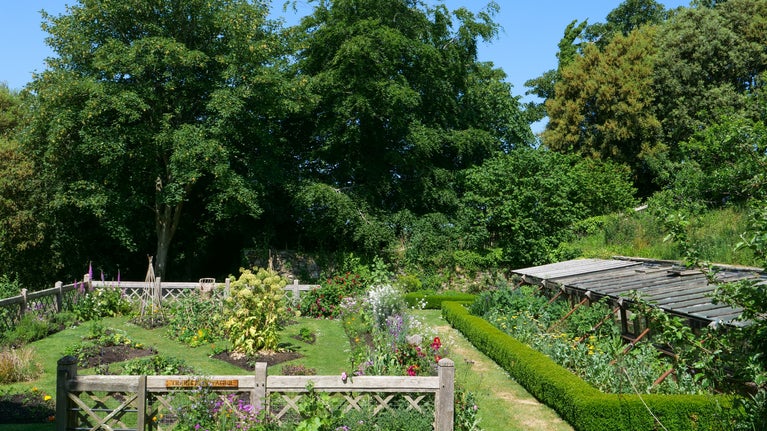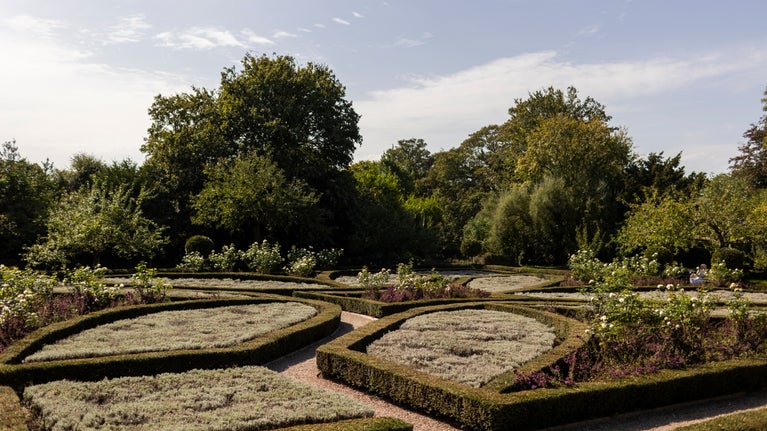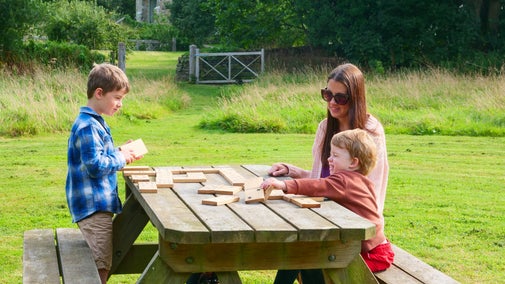
Discover more at Trerice
Find out when Trerice is open, how to get here, the things to see and do and more.

From the knot garden, inspired by grand Elizabethan ceilings, to the wilderness of the mowhay where wildlife thrives, the garden at Trerice is full of variety.
Eight hundred young yew trees grow in the Elizabethan-inspired knot garden planted at Trerice in 2013. The layout mirrors sections of plasterwork in the Great Chamber, a room in the house which overlooks the weaving paths and provides one of the best views of the design as it passes through the seasons.
The flowers planted include marjoram (Origanum laevigatum 'Herrenhausen') and lavender (Lavandula angustifolia 'Silver Mist') which attract pollinating insects, especially local bees and butterflies. Return for the dense petals of repeat flowering floribunda roses 'Sweet Child of Mine' that bloom until the first frosts.
Shelter from sun and showers in the compact wooden summerhouse with a good view of the knot garden and orchard.

This is the highest part of the garden with views of nearby countryside which was once part of the Trerice estate. Play a game of Cornish kayles, a local variation of traditional skittles, among the hardy pink and white cyclamen found in autumn and spring beneath the trees.
The parade ground’s name comes from the time when The Choughs, Newquay’s home guard unit, exercised at Trerice. The wide stretch of lawn is a perfect spot for a picnic, to take in the early autumn sun, toss a round of quoits or play a game of 'slapcock' an early variation of badminton.

A small orchard of apple trees surrounds the knot garden with an emphasis on traditional Cornish varieties including Cornish Longstem, Pascoe’s Pippin and Cornish Aromatic. Butterflies are attracted to windfalls and overripe apples and can often be seen stopping for a sweet treat.
In autumn you can pick your own apples, for a small donation, or purchase a ready-picked bag from the welcome team in reception. Local food banks also visit Trerice and collect apples for the nearby community.
Open for the summer months, the mowhay field is a habitat full of natural plants and wildlife. Stinging nettles and brambles remain in the field and grass grows tall around the cut spaces shared with visitors. The nettles are a vital food for butterflies and the brambles a haven for hedgehogs.
The mowhay is closed throughout the autumn and winter months to allow the field to be grazed.
There are several eco hives installed around the site that aid in the rewilding of bees in the area. They provide a suitable habitat for them to thrive, when once they would have taken advantage of naturally formed hollows in the trunks of mature trees.
You might also spot small wooden bird nesting boxes around the gardens, which the gardeners and volunteers have been busy making and installing in order to provide a safe habitat for small birds.

Find out when Trerice is open, how to get here, the things to see and do and more.

Explore inside the house to see decorative plasterwork and collection items including a large table, Cornish paintings and a 300-year-old clock.

Discover what family-friendly activities are on offer at Trerice. Try a game of Cornish kayles, spot the mice around the house and try on Tudor-inspired costumes in the hayloft.

Find out where to grab some refreshments, and buy gifts and souvenirs during your visit to Trerice.

Find out which families inherited and lived at Trerice. Discover how money was gained through the Royal Court and who were absent landlords.

Find out how our conservation team deep cleans the rooms and collection at Trerice every winter while the house is closed, and what our archaeology research group found in the garden.

From 18th-century water gardens and Arts and Crafts landscapes to intimate woodland gardens, there are so many places to discover.

Discover our gardeners’ top tips so you can make the most of your garden, plot or window box.

Cornwall is not only home to dramatic coastline and countryside, but also a number of beautiful and historic gardens and parks. Discover colour and interest at hidden gems across Cornwall with your family.